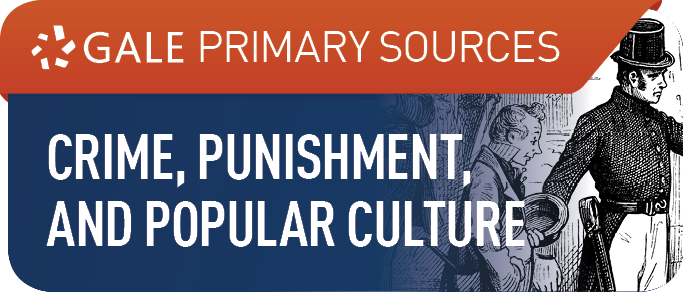Crime, Punishment, and Popular Culture, 1790-1920
Back to
Primary Sources
>
Standalone Collections

===Product Icon===

===Pages===
• More than 2 million
===Document(s)===
• Crime, Punishment, and Popular Culture, 1790–1920
===Title List===
• Crime, Punishment, and Popular Culture, 1790–1920
===Pages===
• More than 2 million
===Document(s)===
• Crime, Punishment, and Popular Culture, 1790–1920
===Title List===
• Crime, Punishment, and Popular Culture, 1790–1920
Explore this international collection of materials to enhance understanding of the evolution of criminal justice and penal reform
With 2.1 million pages of trial transcripts, police and forensic reports, detective novels, newspaper accounts, true crime literature, and related ephemera, Crime, Punishment, and Popular Culture, 1790–1920 presents the broadest and deepest collection of materials supporting the study of nineteenth-century criminal history, law, literature, and justice. This quintessential resource enhances understanding of the intersection of law and society during a pivotal era of social change.
This unique international collection helps researchers explore the causes and effects of the rise in crime during the Industrial Revolution, the development of metropolitan police departments, and the public's fascination with increasingly sensational accounts of crime in newspapers and fiction. It covers changing attitudes about punishment and reform that led to such practices as solitary confinement, prison work programs, and penal transportation, as well as "scientific" theories such as phrenology, which posited that character could be determined by physiognomy.
With 2.1 million pages of trial transcripts, police and forensic reports, detective novels, newspaper accounts, true crime literature, and related ephemera, Crime, Punishment, and Popular Culture, 1790–1920 presents the broadest and deepest collection of materials supporting the study of nineteenth-century criminal history, law, literature, and justice. This quintessential resource enhances understanding of the intersection of law and society during a pivotal era of social change.
This unique international collection helps researchers explore the causes and effects of the rise in crime during the Industrial Revolution, the development of metropolitan police departments, and the public's fascination with increasingly sensational accounts of crime in newspapers and fiction. It covers changing attitudes about punishment and reform that led to such practices as solitary confinement, prison work programs, and penal transportation, as well as "scientific" theories such as phrenology, which posited that character could be determined by physiognomy.
The hand-written material included in the collection has Handwritten Text Recognition (HTR) applied. HTR allows handwritten documents to be full-text searchable, just as Optical Character Recognition (OCR) allows printed books, newspapers, and other works to be searched. This enables unexpected discoveries not possible from traditional finding aids. This technology makes the documents in this collection more accessible to those without paleography skills and enables powerful inclusion in digital humanities/ scholarship projects.
Only Crime, Punishment, and Popular Culture, 1790–1920 helps users explore the links between fact and fiction by integrating legal and historical documents with literature, an emerging crime-fiction genre, newspaper reports, and more.
Through this unique archive, researchers can search and discover essential primary documents such as trial transcripts, case notes from renowned judges, documents from detective agencies, documents related to the development of the police force, crime-related broadsides, criminal justice- and crime-related periodicals, detective fiction, mystery novels, materials related to the theory of phrenology, true crime literature, prisoner photographs, documents detailing statistics related to policing and crime, and more, all sourced from premier institutions such as the U.S. National Archives, the American Antiquarian Society, the U.K. National Archives, the British Library, the Library of Congress, Cambridge University Library, the Harvard University Law Library, and the State Library of Queensland. Engage students and explore topics across the following disciplines:
• History
• Literature
• Women’s studies
• American studies
• British studies
• Criminal justice
• Sociology
Only Crime, Punishment, and Popular Culture, 1790–1920 helps users explore the links between fact and fiction by integrating legal and historical documents with literature, an emerging crime-fiction genre, newspaper reports, and more.
Through this unique archive, researchers can search and discover essential primary documents such as trial transcripts, case notes from renowned judges, documents from detective agencies, documents related to the development of the police force, crime-related broadsides, criminal justice- and crime-related periodicals, detective fiction, mystery novels, materials related to the theory of phrenology, true crime literature, prisoner photographs, documents detailing statistics related to policing and crime, and more, all sourced from premier institutions such as the U.S. National Archives, the American Antiquarian Society, the U.K. National Archives, the British Library, the Library of Congress, Cambridge University Library, the Harvard University Law Library, and the State Library of Queensland. Engage students and explore topics across the following disciplines:
• History
• Literature
• Women’s studies
• American studies
• British studies
• Criminal justice
• Sociology
FEATURED REVIEW
“There is much remarkable material here……Not only is the content extraordinary, but the navigation through these primary sources is the fast and easy. VERDICT This enthralling and straight-forward file will be well worth its purchase price to libraries supporting serious legal, historical, and criminal justice researchers.”
Back to
Primary Sources
>
Standalone Collections






